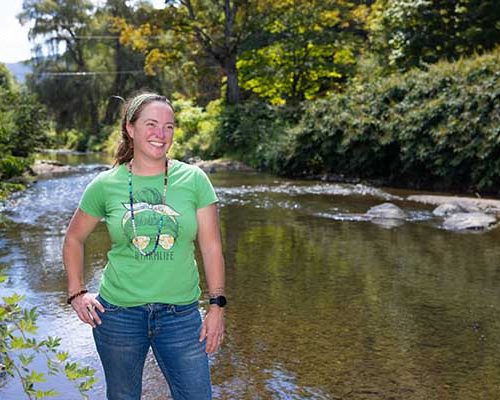Emily Davis ’12: Engineer with a purpose


Hurricane Helene damaged or destroyed a reported 3,200 driveways, bridges or culverts in Ashe County, North Carolina, making it impossible for many residents to leave their property. As soon as conditions cleared and the ravaged mountain landscape was cautiously navigable, Emily Davis ‘12 and her husband Leeth didn’t waste time making rounds across the county to deliver meals, medicine and other essentials.
“Lansing was completely under water. When we pulled into town three days post-hurricane, people were working in every building, mucking out mud, trying to put their town back together,” Davis said. “It’s an incredible community.”
It didn’t take long, however, for the Davises to realize that the gravity of their situation outweighed the power of the all-terrain vehicle they were using to traverse creeks, culverts and washed out roads to meet their neighbors’ needs. “Restoring access was a major priority,” said Davis. “The damaged bridges on private property were ineligible for repair or replacement through public funds or standard homeowner’s insurance; at an average cost of $50,000 each, we would need a creative and sustainable solution.”
Up and running
Davis, a licensed structural engineer with private, public and entrepreneurial experience, together with her husband, whose background is in construction and logistics, local business owner Steven Howell and lifelong resident, the late Lora Young, understood that trying to solve every obvious problem folks were facing wasn’t possible — or even practical. They decided to zero in on raising funds to address bridge repairs and road access in Ashe County, and founded Lansing’s Bridge to Recovery. To support the nonprofit’s mission, they created a tracking and mapping system that lists each project by location, guiding the hundreds of volunteers who arrived daily with equipment and energy to areas of specific need.
One volunteer was David Dugan, a Florida-based drone surveyor, whose offer to take aerial footage of the various damage sites could significantly increase the number of designated work sites from the few they were able to capture daily to dozens. To keep up the pace of clean up — and eventually repair — Dugan suggested that Davis reach out to her alma mater, UNC Charlotte’s William States Lee College of Engineering for solutions. Once connected, Davis was directed by her former professor, William Saunders, to his colleague Shen-en Chen.

1) Drone surveyor David Dugan changed the trajectory of Lansing Bridge to Recovery’s work with the introduction of drone technology, and is sharing his knowledge with Charlotte students. 2) Volunteers from StoneBridge Church Community in Charlotte, organized by Shen-en Chen, have contributed their time and treasure to LBR’s efforts in Ashe County. 3) UNC Charlotte engineering students in Chen’s bridge design course learn on site the value of knowing the geography.
“Dr. Chen has been incredible,” Davis said. “Not only did he put together a bridge design class for his students in record time — and have it approved so enrollment could begin in January — his background in volunteerism has been a perfect match for our needs.”
Bridge design, geographic information systems – and credibility

Chen, a professor of civil and environmental engineering, visited Ashe County early in the spring semester with his students to get a firsthand look at the sites designated for new bridges. To complement the students’ efforts, Chen and other UNC Charlotte faculty members developed an algorithm that puts precise information in the hands of local contracted engineers, whose expertise is essential to accelerate the overall rate of bridge replacement. And the University’s Center for Applied Geographic Information Science, led by Wenwu Tang, created an interactive platform that provides a broad overview of the geography as well as “nitty gritty data” about hydraulics, drainage and structures themselves.
“Collaborating with UNC Charlotte has raised LBR’s credibility — particularly with the state — exponentially,” said Davis. “Our successes would not be possible without the University’s expertise and willingness to help.”
For example, LBR recently made a presentation to the North Carolina Department of Public Safety to qualify for a new program that will reimburse approved nonprofits’ costs for bridge repair and replacement on private roads and property. “They were very impressed by the research, data and designs from UNC Charlotte,” Davis explained. “Now, LBR is one of only three nonprofits to be approved for reimbursements by North Carolina’s Tropical Storm Helene Private Bridge and Road Program.”
The collaboration goes a step further. There is only one qualified, North Carolina Department of Transportation-registered bridge building contractor — a credential required for reimbursement — in Ashe County. Because of Charlotte’s high-quality designs, LBR will be able to hire local contractors as long as they have bridge-building experience, expediting the process. (The usual permitting and inspection processes remain in place.)
Looking ahead
To date, LBR has completed about 100 bridges in Ashe County, about one-third of those on the master list compiled last winter. This includes 15 built with the aid of UNC Charlotte’s algorithm. Two bridges designed by UNC Charlotte engineering students will be completed this fall. Plus LBR has expanded its scope to include other aspects of access, including for wheelchairs.
“We know this work will take years, and Lansing’s Bridge to Recovery is in it for the long haul,” Davis said. While reimbursement for completed structures is forthcoming, upfront funds — and fundraising — always will be necessary. “The reimbursements will keep us operational and will cover the next project on our schedule.”
In UNC Charlotte’s future engineers, Davis sees the passion that drew her as a student to structural engineering. “It’s exciting to see something you design become real, and this project is providing students a real-life opportunity, complete with bumps in the road,” she said. “It’s wonderful to see them so motivated.”
Written By Susan Messina
READ MORE ABOUT THIS PROJECT: Building Bridges: Niner engineers support a community’s recovery